Clyde Pottery Marks
The Clyde Pottery used a large variety of marks to identify its wares. The marks often correspond with particular patterns and hence the mark name and pattern are often the same. Certain marks are used during specific periods thus making it possible to date pieces. Normally the pottery was consistent in using the terms C.P. Co. and C.P.Co. Ltd. but during the Thomas Shirley period of ownership from 1841 until 1857 the abbreviation T.S. & Co. is also found.
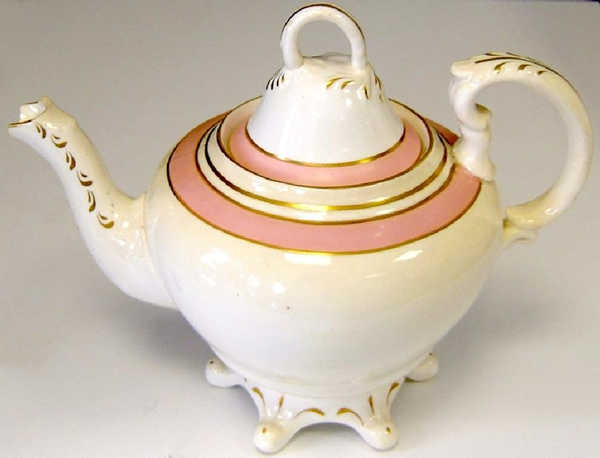
2001.292 - © The Watt Institution
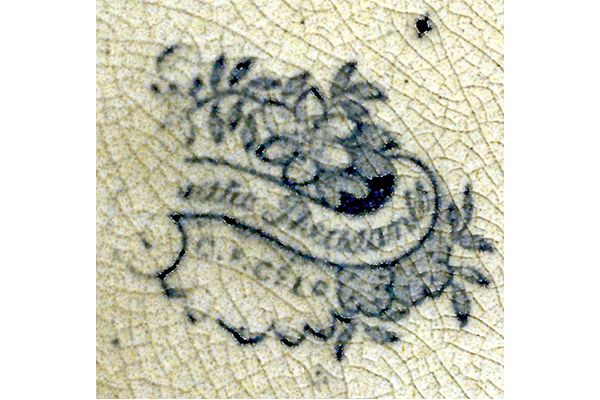
Asiatic Pheasants Mark 1858-1862
Copper plates of this very well-known design were acquired by very many British potteries in the mid-1800s. The Clyde Pottery was no exception; a fine ashet of this design bears the maker's initials C.P.Co. identifying it with the pottery's first 'Limited' phase. © McLean Museum and Art Gallery, Greenock.
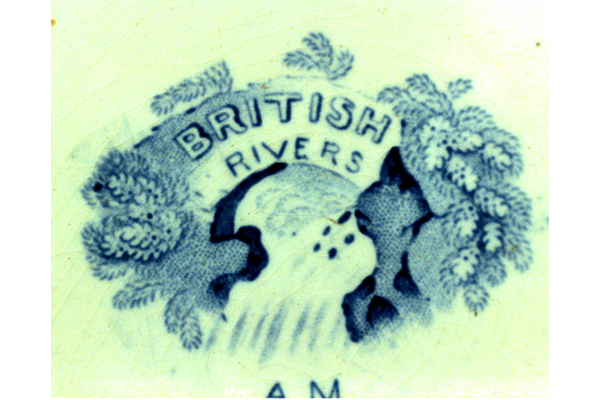
British Rivers 1816-1840
The series 'British Rivers' was a collection of fanciful river scenes with trees, bridges and buildings being switched about to give a variety of pictures. Production must have been considerable, in sets of dinner-ware, as many pieces are still in circulation usually marked A.M. (Andrew Muir). © McLean Museum and Art Gallery, Greenock.

Caledonian A.M. Mark 1816-1840
The pattern shows a horseman with feathered bonnet, mounted attendant and dogs in a landscape with pointed mountains, lateen sailed boat on lake, and 'Windsor' type castle. The border was of alternating large daisies & acanthus leaves. Marked in script & A M in capitals, in a decorated oval. © McLean Museum and Art Gallery, Greenock.
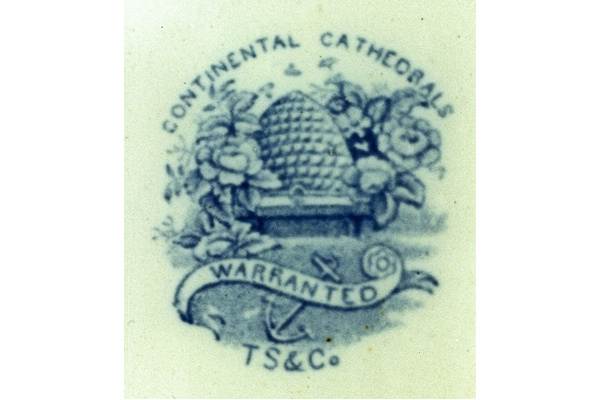
Continental Cathedrals 1840-1857
This pattern of religious buildings appears to have been the Shirleys' equivalent of the 'British Rivers'' series. The mark is usually beehive & 'Warrented' with anchor & T.S.& Co. Mainly found on large dinner-ware and mugs. © McLean Museum and Art Gallery, Greenock.
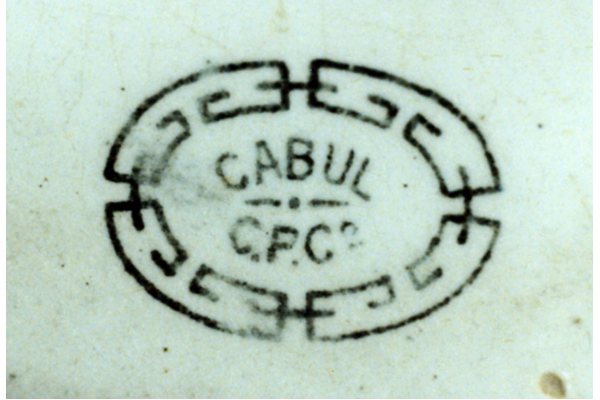
Cabul 1863-1875
This pattern employs Tudor roses and tropic birds in reserves, on a border of Persian swastikas; centre-piece of Chinese furniture & plants. In black or sepia usually on punch bowl, often hand painted over the glaze in polychrome with lustre edge. Mark in capitals in 'Chinese' oval, and C.P.Co. © McLean Museum and Art Gallery, Greenock.
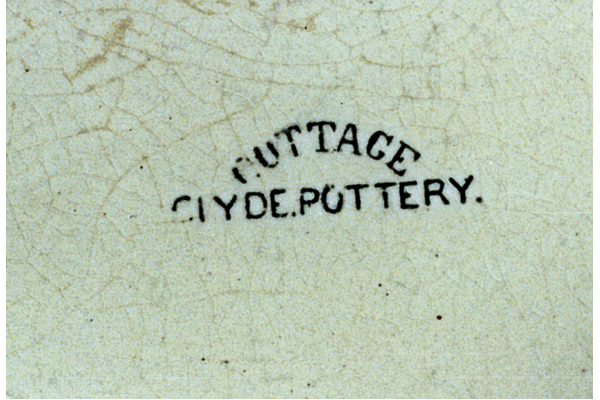
Cottage Mark 1890-1905
This pattern was used on jugs in the form of round-headed side-reserves with cottage picture; surrounded with spray of Michaelmas daisies; the top border has bishop's mitres & ribbons with daisy-spray mark in capitals. The mark is COTTAGE (curved) over CLYDE POTTERY. © McLean Museum and Art Gallery, Greenock.
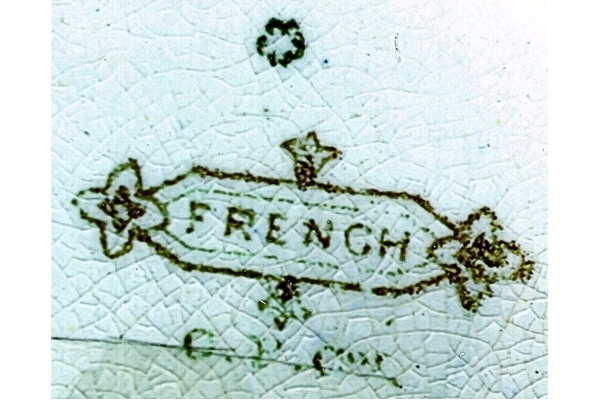
French Mark 1863-1875
French pattern employs a design featuring a swain in 18th Century dress, leading his horse, conversing with a girl in a vineyard. Decorated with a border of vine-leaves. The pattern was much reproduced on jugs where it was printed in black, brown or puce often with a hand painted overglaze. The mark is in capitals in lozenge cartouche, with C.P.Co. underneath. © McLean Museum and Art Gallery, Greenock.
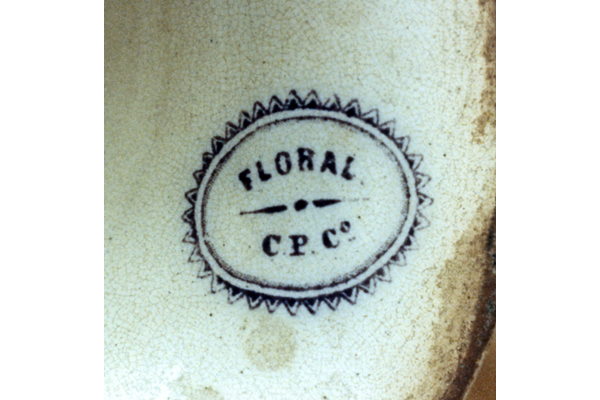
Floral Mark 1885-1900
The ‘Floral’ design and mark is based on a convolvulus flower design, it is found on punchbowls. © McLean Museum and Art Gallery, Greenock.
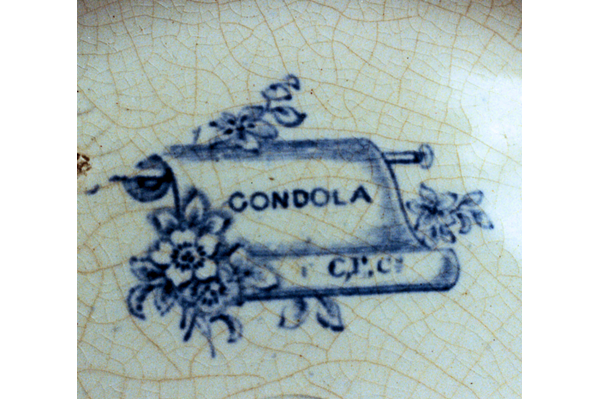
Gondola Mark 1844-1851
The ‘Gondola’ pattern features a rather improbable multi-oared boat with a stern canopy in a lacustrine scene with 'Italianate' buildings. It was widely used on toilet-sets, punch-bowls and jugs, but it is not always marked. The mark is usually blue printing on a scroll’ GONDOLA’ over C.P.C. Co. © McLean Museum and Art Gallery, Greenock.
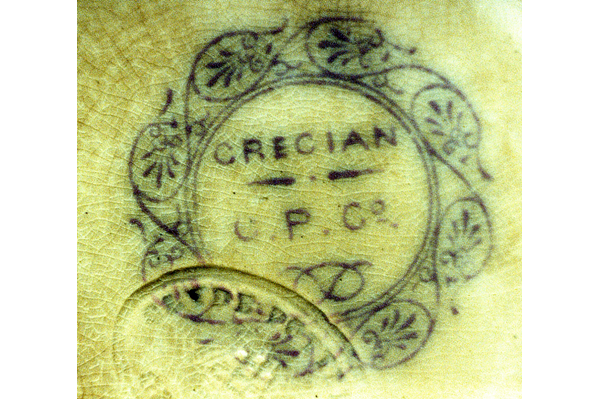
Grecian Mark 1863-1890
‘Grecian’ employs a classical scroll centre piece with stylised acanthus. The mark is GRECIAN over dotted line over C.P.Co. in a Grecian style rosette. Found on puce-printed tureen with dog-rose moulded handle but the same design appears on a plate marked J.&W.P. Bell. © McLean Museum and Art Gallery, Greenock.
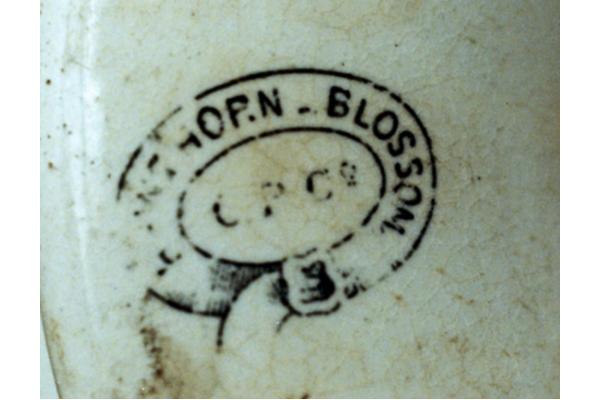
Hawthorn Blossom Mark 1863-1875
‘Hawthorn Blossom’ uses sprays of hawthorn, well-drawn, printed in various colours and often with hand painted overglaze, usually on found on punch-bowls or mugs. Also with lustre border-band and red-orange rim-line. Mark is on an oval garter with C.P.Co. central. © McLean Museum and Art Gallery, Greenock.
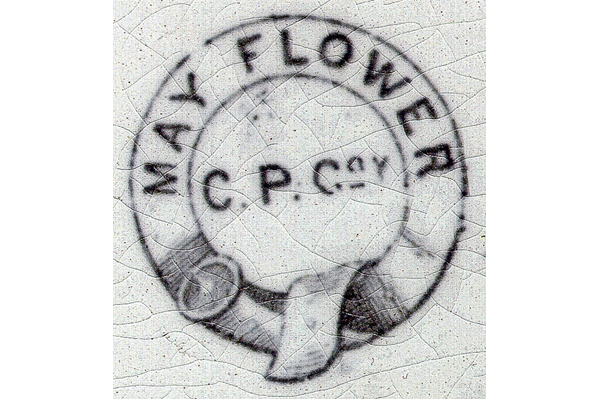
Mayflower Mark 1880-1900
The design employs romanticised may-blossom with 'Mayflower' ship in reserves also heavenly bodies in geometric reserves. Usually printed in grey sometimes hand painted overglaze with orange-red rim on dinner service and punch-bowls. The mark is MAYFLOWER in garter with C.P.Coy. central. © McLean Museum and Art Gallery, Greenock.
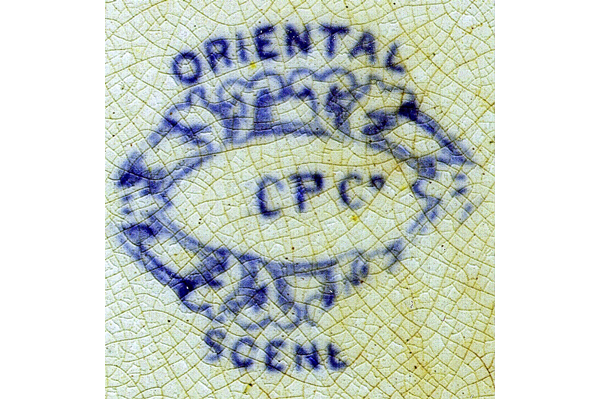
Oriental Scenery 1850-1865
‘Oriental Scenery’ pattern features an oriental lake with terracing in the foreground, feathery palm-tree, distant river mountains and border. The background is a chess-board pattern; blue printing. The oval cartouche contains the mark C.P.CO. offset to the right and sometimes the mark T.C.P.Co., with the T faint, indicating the Shirley period and use by their successors. Also found with impressed maple-leaf with C.P.COY with serifs. © McLean Museum and Art Gallery, Greenock.
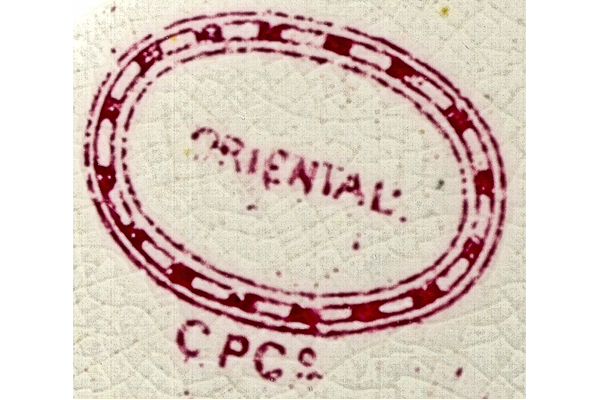
Oriental Mark 1863-1880
Using a design similar to 'Indian Tree' printed in black or red/brown, sepia flow-blue on jugs and punchbowls, often with a hand painted overglaze. Pattern name in oval C.P.Co. under. © McLean Museum and Art Gallery, Greenock.
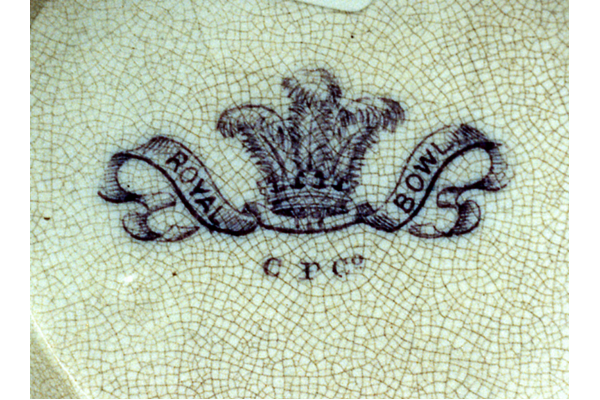
Royal Bowl Mark 1863
Found on pieces commemorating the engagement of Prince of Wales to Princess Alexandra married in 1863, On jugs and punch-bowls printed in puce with portraits in reserves also in blue; often hand painted overglaze in brown lustre & pink. © McLean Museum and Art Gallery, Greenock.
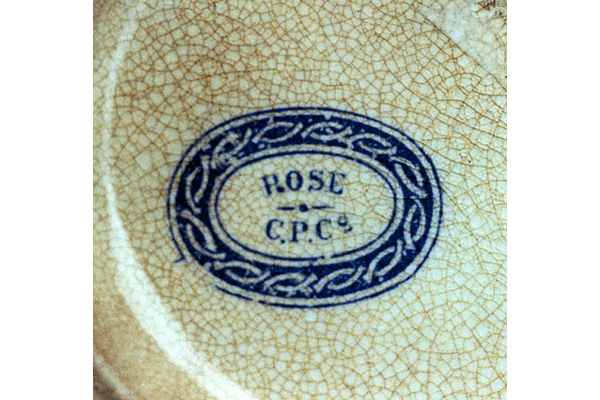
Rose Mark 1880-1890
The Rose pattern shows a little girl at a window with distant scene in the background. She is feeding a cat. Found on jugs with the pattern name over dotted line over C.P.Co. in oval. © McLean Museum and Art Gallery, Greenock.
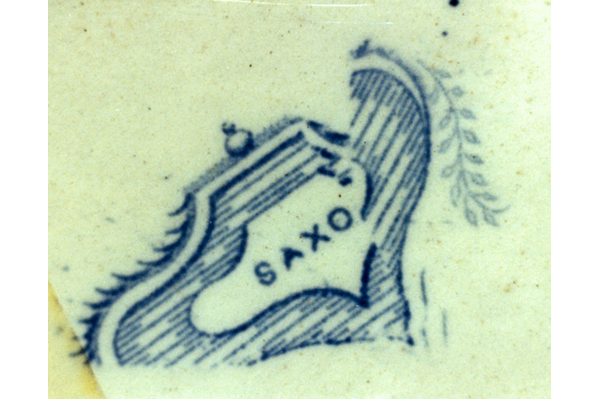
Saxon Mark 1840-1857
This pattern shows Saxons net-fishing on a lake beside a round-towered castle. Border copied from 9th century Saxon pottery combined with lined border & castles in reserves. Found on jugs, toilet ware and punch-bowls; with various marks including beehive/anchor, sailing yacht; usually printed in grey but also in blue. © McLean Museum and Art Gallery, Greenock.
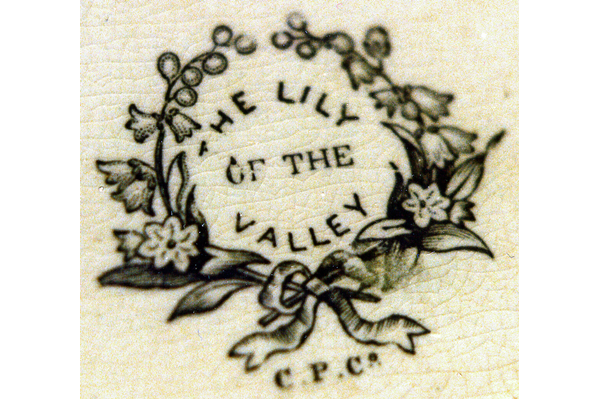
Lily of the Valley Mark 1863-1875
Lily of the Valley in centre and border, often picked out in hand painted overglaze. Widely used on punch-bowls, toilet seats and wall plaques. Usually marked C.P.Co. but sometimes seen with a sailing yacht mark. © McLean Museum and Art Gallery, Greenock.
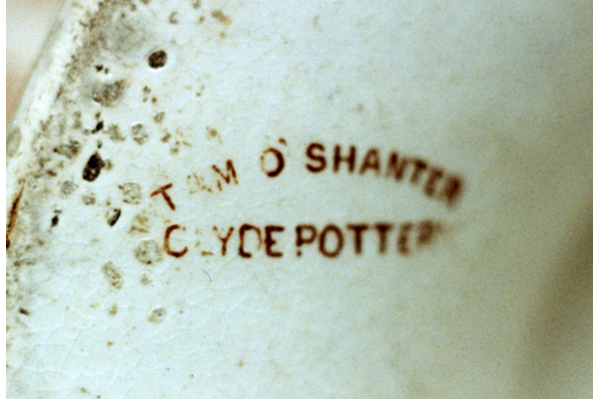
Tom O'Shanter Mark 1875-1890
This pattern and mark are found on a great variety of ware, but mainly punch bowls and wall plaques. Mark is TAM O'SHANTER, curved over CLYDE POTTERY. © McLean Museum and Art Gallery, Greenock.
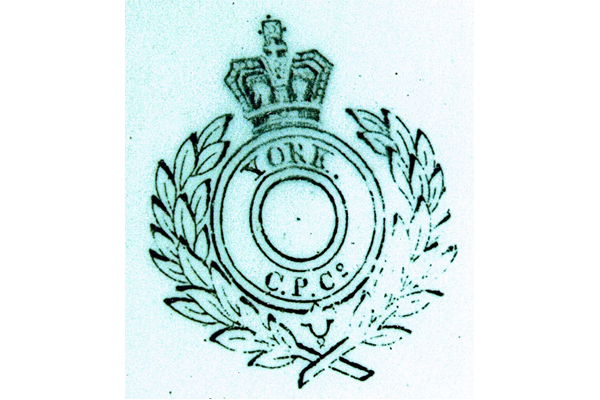
York Mark 1875-1890
The York pattern consists of large (white) roses sometimes painted over glaze; mark on circular garter in wreath; found on jugs and small bowls. © McLean Museum and Art Gallery, Greenock.
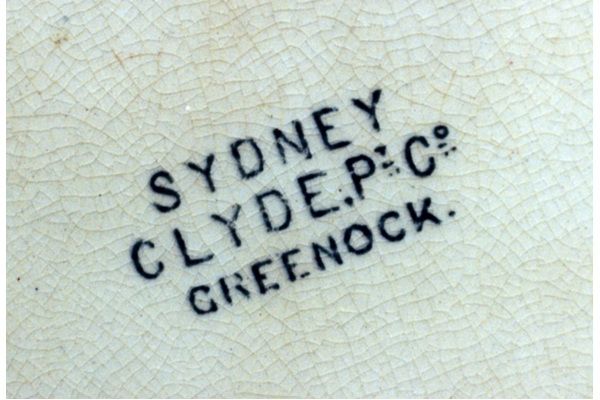
Sydney Mark 1890-1900
The Sydney pattern uses floral and geometric patterns; it has cornflower sprays (like Mayflower). The pattern has been found printed grey on plates and ashets. The mark is SYDNEY over CLYDE Pt. Co. over GREENOCK. © McLean Museum and Art Gallery, Greenock.
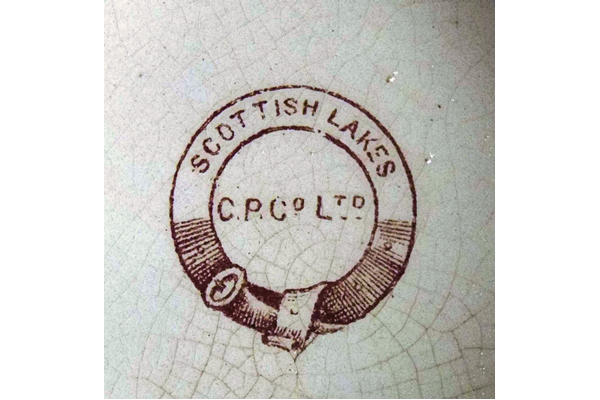
Scottish Lakes 1901-1905
This is a late period mark used, in this instance, on a piece with the Scottish Lakes pattern a design with a loch scene with stags mixed with geometric motif. © McLean Museum and Art Gallery, Greenock.
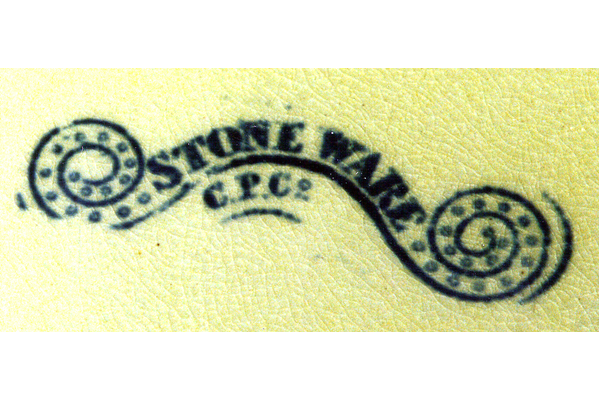
Clyde Pottery Stoneware
Clyde Pottery Stoneware mark. This mark is less common but has been seen on the reverse of a 'willow pattern' plate.
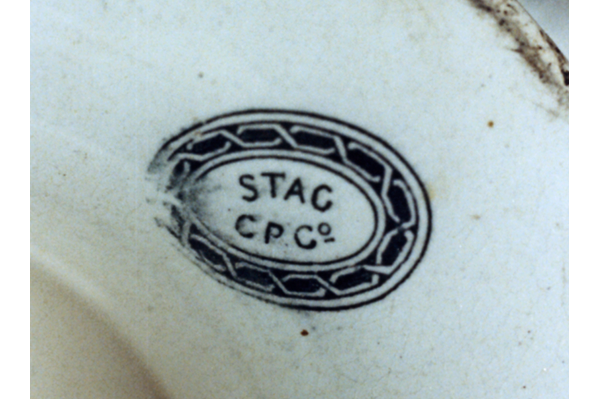
Stag Pattern Mark 1875-1890
The romantic animal pattern is usually found on punchbowls often with a hand painted overglaze in polychrome. Mark in oval with C.P.Co. © McLean Museum and Art Gallery, Greenock.
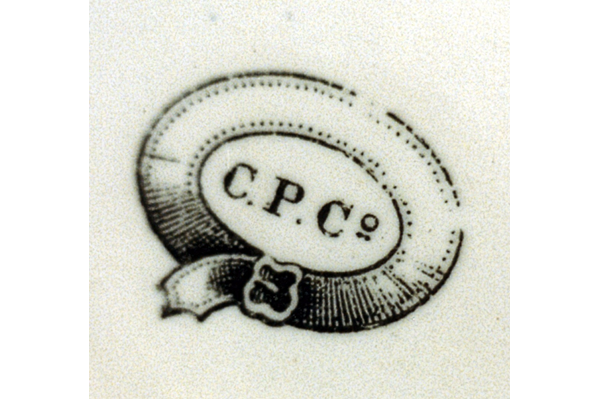
C.P.Co. Mark
This a mark generally found on late period productions of the Clyde Pottery Company.
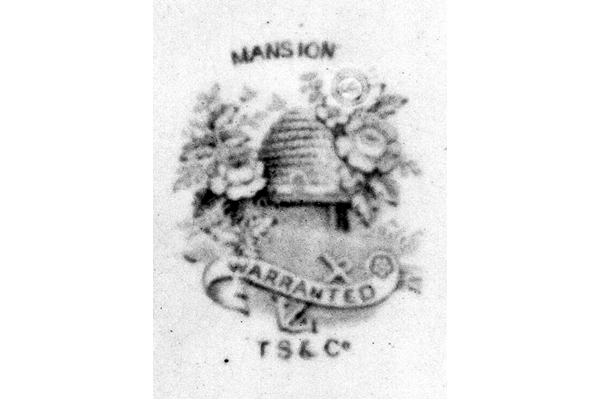
Mansion Mark 1844-1857
This mark for the Mansion pattern is similar to other marks used during the Thomas Shirley period of ownership of the pottery when the company traded as Thomas Shirley & Co. © McLean Museum and Art Gallery, Greenock.
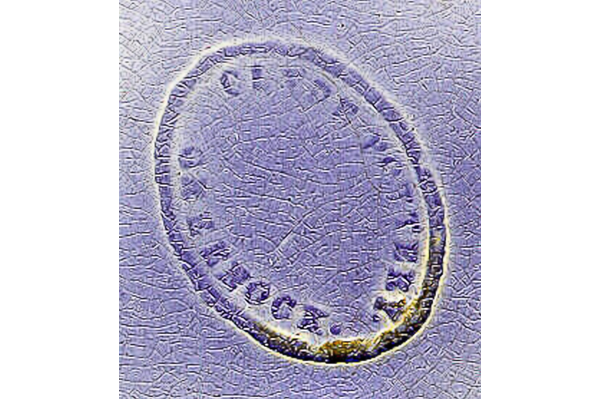
Clyde Pottery Impress Mark
This impress mark was used alongside other pottery marks, for example it has found with the 'Gondola' pattern mark. © McLean Museum and Art Gallery, Greenock.
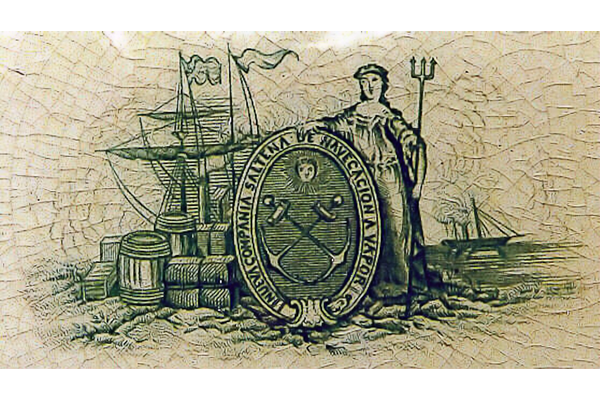
Nueva Compania Mark
This mark illustrates part of the Clyde Pottery business in supplying ceramics to ships. This example is found on a dinner plate and was made for the 'NUEVA COMPANIA SALTENA DE NAVECACION A VAPOR.' © McLean Museum and Art Gallery, Greenock.



























